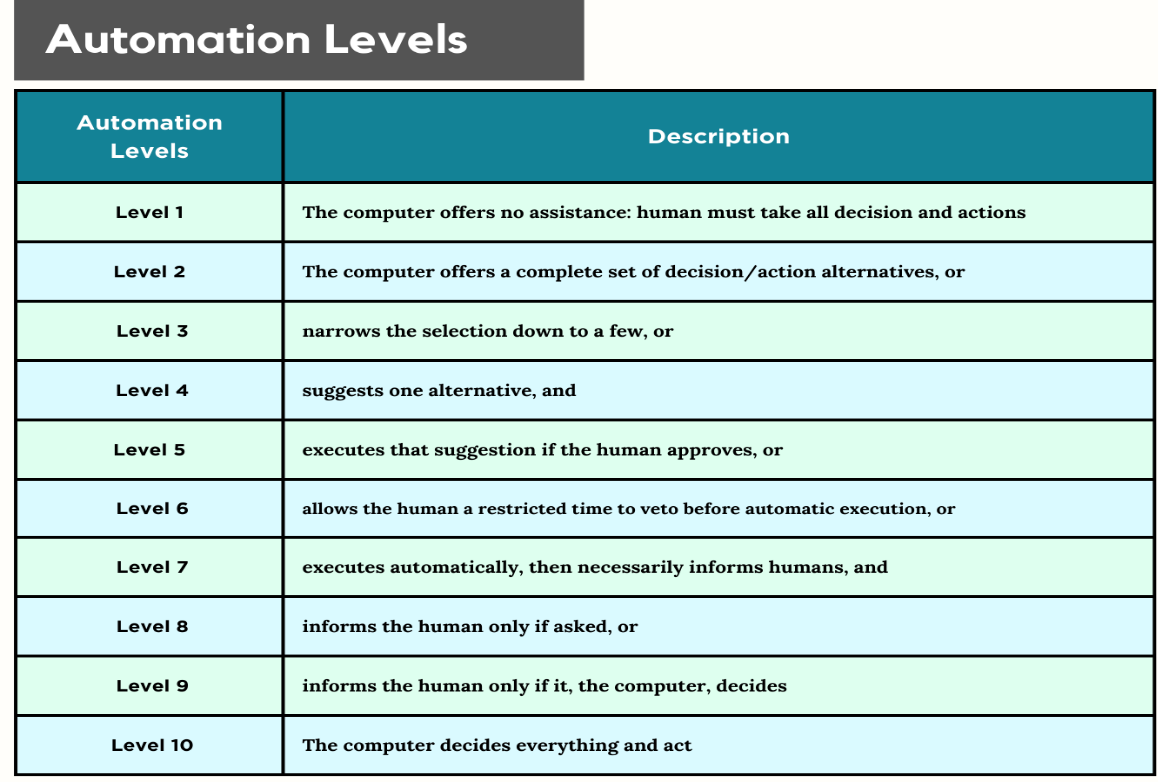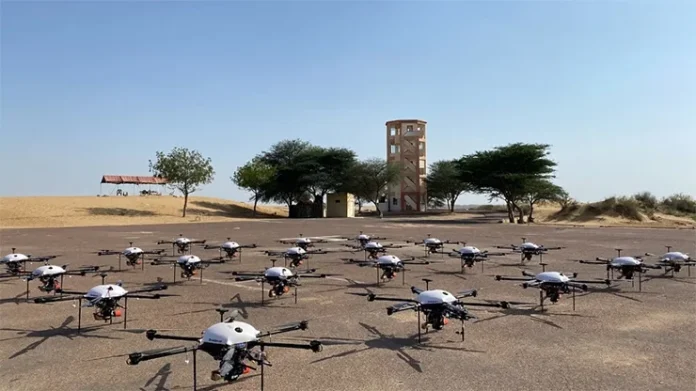Smart War-Fighting Array of Reconfigured Modules or SWARM is enabled by the confluence of two interrelated technologies – artificial intelligence and machine learning. Multiple unmanned platforms with or without weapons are deployed in a SWARM configuration to achieve a common goal, with the platforms autonomously modifying their behaviour based on communication with one another. SWARM can potentially alter the battle space and character of 21st century warfare. As a result, SWARM has attracted significant interest from the world’s most powerful militaries.
During the December 2017 Global Fortune Forum in Guangzhou, China, a stunned audience watched 1,108 drones working in tandem. But this display was not based on SWARM concept. In essence, it was a large group of robotic drones that had been pre-programmed to perform a series of aerodynamic manoeuvres. Hundreds of drones lighting up the sky and seamlessly synchronising to myriad forms during sporting, and cultural events have mesmerised the Indian public in recent times. These ‘drone show’ aerial demonstrations should not be construed as SWARMS. Unlike robotic drones, SWARM UAVs are characterised by a set of capabilities (see Table 1).
SWARM UAVs have traits that are comparable to those of a soccer team; the comparison simplifies the comprehension of the complex technology (see Table 2). Evidently, there are many parallels between a soccer team and a UAV SWARM. However, there are also a few noteworthy variations. The soccer team faces similar opposition, while the SWARM is unlikely to be applied against similar opposition. A soccer team has a fixed number of players, whereas the number of UAVs in a SWARM team can vary, and is scalable. While the SWARM UAVs can carry weapons into the mission area, the soccer team cannot enter the field with weapons.
SWARM UAVs have traits that are comparable to those of a soccer team. However, there are also a few noteworthy variations. The soccer team faces similar opposition, while the SWARM is unlikely to be applied against similar opposition. A soccer team has a fixed number of players, whereas the number of UAVs in a SWARM team can vary, and is scalable
Table 1: SWARM features

Table 2: Similarities between Soccer team and SWARM

Advantages of SWARM
SWARM’s advantages stem from its features and range of control setup possibilities (see Figure 1). Irrespective of the control models, UAVs in SWARM can be employed in two modes: massed and dispersed. SWARM, as “massed UAVs,” starts off as a single massed body, then disassembles and conducts a convergent attack to swarm the enemy from several directions. When deployed as “dispersed UAVs,” the swarmer UAVs are first scattered, then they regroup on the battlefield and launch an attack without ever becoming a single-massed entity. Regardless of configuration, the following is a summary of the key advantages of SWARM UAVs.
- SWARM UAVS have a significant advantage in that they have a “mind of their own.”
- Combination of several sets of UAVs that are more effective than the individual UAVs, contributing to a synergy effect—anti-jamming and anti-radiation weaponry, for example, in one SWARM.
- A UAV SWARM has greater self-protection than individual UAVs. Compared to single-UAV operations, SWARM offers better coverage and precision, higher safety, and more flexibility.
- Distributed sensor deployment for reconnaissance, observation, tracking, tracing, and assaulting is well-suited for search and destroy operations over large areas, especially for mobile or other hard-to-find targets.
- Can be tailored to the needs of a specific situation or mission, for example, an air defence strike and/or surveillance.
- Slow-moving smaller UAVs, albeit in large numbers, are more difficult to detect and target.
- Enormous psychological impact on the adversary with skies flooded with UAVs.
- Given the low cost of each UAV, a multitude of them can be deployed in almost every situation. Furthermore, when equipped with onboard software, they can respond quickly and with minimal outside intervention to abrupt changes in their surroundings.
SWARM UAVs are often discussed in the context of automation level 10. The UAVs are expected to fly to the target area, find their target, and destroy them while ensuring self-protection. All of these are intended to be accomplished without requiring human intervention after launch
Figure 1. SWARM control options

SWARM Capability Analysis
- Automation Levels. The widely acknowledged automation levels are depicted in Table 3. SWARM UAVs are often discussed in the context of automation level 10. The UAVs are expected to fly to the target area, find their target, and destroy them while ensuring self-protection. All of these are intended to be accomplished without requiring human intervention after launch. Therefore, fully autonomous SWARM UAVs operating at Level 10 must be self-organised, object-oriented systems working on complex algorithms involving a high degree of computation complexity that can process high-speed commands within a meshed communication network with reasonable redundancy. A few years ago, an ostensibly SWARM demonstration was carried out on Army Day in Delhi. During the display, constant human intervention was apparent to the astute viewer. SWARM operating with Level 10 automation is not easy to design and develop, and thus human intervention should be accepted, at least in the foreseeable future. Control of a large number of UAVs with human involvement, i.e., below Level 10 automation, can be challenging and will require a large number of personnel.
Table 3: Automation Levels

- Performance parameters. Currently, the Micro class and, to a lesser extent, the Mini class account for most of the UAVs used in the SWARM arrangement. These UAVs have limited capabilities in terms of endurance, range, and payload capacity. Longer ranges are made possible by mesh networks; however, endurance constraints limit the range. Inconsistent endurance will arise when UAVs from several classes are fielded in combination for specific tasks. Negating this drawback will add to the complexity of the SWARM design. In high-altitude terrain, the payload-carrying capabilities are significantly reduced, and hence, these UAVs as weapon platforms will be less effective. Consequently, a larger number of UAVs will have to be deployed to achieve a higher degree of destruction. SWARM UAVs can be launched from the ground, a tube, or an aircraft. Aircraft-launched SWARM UAVs can be deployed near the target. But this entails having a dedicated resource, i.e., aircraft, for employing SWARM. India’s land borders with its two hostile neighbours exceed 5000 km, and to cover such a vast area, India will require a large number of SWARM UAVs. In vast and challenging terrain, employing SWARM configurations of Micro and Mini UAVs with limitations of performance parameters, mostly multicopters, is a major drawback. These multicopters with endurance ranging from 45 minutes to 90 minutes will have limited utility in undertaking protracted surveillance, hunting potential targets, and striking them. But they can be useful for striking a high-value target based on prior intelligence. But given their low payload capacity, are these SWARMS the best option for striking a high-value target when prior intelligence is available?
- Cost. Decentralised decision-making, self-organisation, distributed intelligence, autonomy, scalability, mesh networks, multi-hop communication, and dynamic spectrum sharing are some of the critical features that UAVs in SWARM configurations can possess. Each of these capabilities adds to the cost of design and development. Achieving higher levels of autonomy will be exponentially expensive. To be an effective hunter-killer, particularly in high-altitude terrain, SWARM UAVs must be of the tactical/short-range class with an endurance of at least 5–6 hours. Such enhanced capabilities will also translate into greater costs for UAVs.
- Positive Control. Not all the data that SWARM gathers is predictable. Programming the SWARM to tackle almost infinite possibilities that might materialise in actual combat circumstances is likewise incredibly challenging. Therefore, SWARM might miss out on critical fleeting opportunities. Consequently, the interface between the SWARM and the controller becomes essential. While the SWARM must function autonomously, it also must be managed in a combat environment. Commanders must be able to understand the SWARM’s assignment, progress, and health without being directly responsible for the activity of each UAV in the SWARM. But at the same time, commanders must have the control to undertake course corrections. Unlike the soccer team’s coach, commanders simply cannot be spectators from the sidelines. This suggests that for SWARM UAVs, a very high degree of autonomy in which the computer controls everything may not be a desirable attribute, particularly for military applications.
SWARM UAVs have not yet been extensively used in actual conflict situations, including the ongoing Russia-Ukraine war. Although Israel is considered a global leader in unmanned technology, it has not yet demonstrated SWARM’s ability to reshape the character of warfare in its current conflict with Hamas
Conclusion
A group of UAVs or loitering munitions in massive numbers, without ‘having a mind of its own,’ employed together is often confused with SWARM. Despite the buzz surrounding SWARM UAVs, these devices have not yet been extensively used in actual conflict situations, including the ongoing Russia-Ukraine war. Although Israel is considered a global leader in unmanned technology, it has not yet demonstrated SWARM’s ability to reshape the character of warfare in its current conflict with Hamas. UAVs in a SWARM configuration have numerous advantages and some serious limitations. Mass deployment is made possible by small, inexpensive UAVs that are hard to detect. However, the cost is likely to increase exponentially with each level of automation. Moreover, small UAVs with low endurance, range, and payload-carrying capacity will have limited impact in combat conditions. UAVs with high endurance, range, and payload capacity, suited for battlefield environments, will be larger, and that will offset the cost and stealth advantage.
Small countries that lack skilled labour and have short hostile borders may stand to gain from these technologies. However, a SWARM UAV with weak performance parameters is unlikely to be an effective force multiplier for a nation like India, which has vast hostile borders and an abundance of skilled human resources. A comprehensive cost-benefit comparison of SWARM UAVs and single UAVs operating with other existing weapon platforms, air- or ground-based, does not tilt the balance in favour of the former. At least in the Indian context, current SWARM technology offers no discernible advantages due to its high cost and limited capabilities.
-The writer is amongst the pioneers of UAS in India and has spent the last 20 years developing a niche specialisation in the technology. He is currently pursuing his PhD on UAS. He has several publications on UAS in reputed international scientific journals, and his work has been cited extensively. The author can be contacted at psramesh1026@gmail.com. The views expressed are personal and do not necessarily reflect the views of Raksha Anirveda





